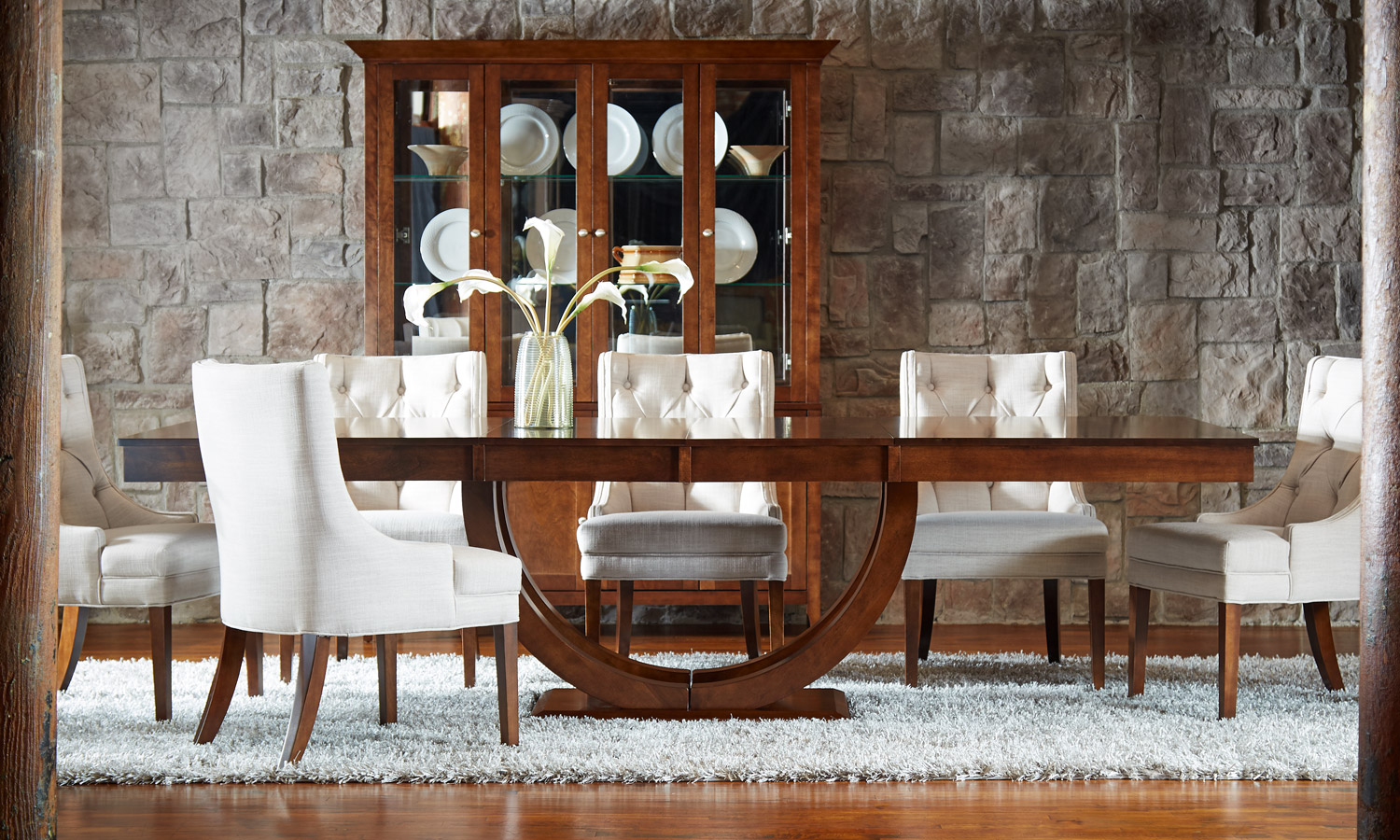
When it comes to hosting a holiday meal, or any dining experience that draws a large crowd, planning the seating can be daunting. We asked interior designer and educator, Mitch Danforth to give his expert insight on the most common seating conundrums.
Mitch’s advice — Begin by embracing that this is a special, out-of-the-ordinary event. There is a certain human scale to most homes, meant for everyday living, and you are likely pushing beyond that scale for the sake of a special occasion. How fun! Let’s dive into the possibilities.

What are the key things to consider when planning seating arrangements for a large dinner party?
Before making specific decisions and selections for the party, take a moment to visualize how you want the party to feel (the “vibe”) and how you want people to feel in your space (comfortable? open? stimulated?). Once you develop a clear vision of the experiences you want to curate, your decisions about layout, food/drink, ambiance, and decorations will more naturally fall into place.
As you consider your space and the number of people you want to seat during the meal, first cast the net wide and consider the possibilities. What rooms in your house could be adjusted into temporary dining spaces for the big night? If you have a dining room, will it fit all of the guests comfortably? I’m a big fan of room swapping in situations like this – turning a living room into a grand dining room and turning a dining room into a more intimate seating area…and putting the extra furniture away to free up space!
Here are some rules of thumb:
1. Be sure to leave enough space for people to get into and out of their seats. A sure-fire way to make someone feel claustrophobic is to not provide enough space behind their chair.
2. Be sure that guests sitting at the same table can see each other’s faces.
3. Everyone sitting at a single table may not be all that it’s cracked up to be. In situations with groups of people who already know each other, a large gathering at a single table will likely result in guests taking on their normal roles, missing an opportunity for guests — especially more reserved personalities — to connect in new ways.
If the amount of guests you invited to dinner outnumbers the number of traditional dining chairs you own, what are some alternative seating options?
Congratulations on inviting more people than matching chairs! There are SO many great ways to seat more people, each with its own flavor. Here are a few options to consider:
Small expansion: If you have matching dining chairs and only need to expand your seating by two people, consider pulling up lounge chairs at the ends of the table, and place your normal end chairs along the sides.
Bench it up: If you need to expand seating by more than a few people, consider incorporating benches into the mix on one side of the table and chairs on the other side.
Embrace a picnic: If you are going to incorporate the trusty approach of a “kids table”, consider using all of your chairs for adults and throwing a picnic on the floor around a coffee table instead. For this bold move, I recommend a picnic blanket for protection, easy cleanup, and ambiance. My colleague Nancy’s input: add some coloring pages and crayons to the picnic area! Kids tend to eat quickly, and staying one step ahead of the game could allow YOUR conversation to continue longer without distraction.
If the space in your dining room allows it, but the length of your dining table does not, how can you extend the number of place settings at a table?
There are many ways to configure tables and chairs to increase the number of dining seats within a room. By minimizing the number of pathways in your dining room, you can maximize the destination space (tables and chairs, in this case).

Here are some sketches showing a typical dining room layout alongside some expanded seating configurations. For the sake of illustration, I’m assuming a large dining room of 12 x 18 feet with two entrances, including one wide opening and one standard doorway opening.

Double: Island & Peninsula
If your dining room has multiple entrances, it’s likely not necessary for a guest to be able to walk around the entire table. Consider placing the end of a table beside a wall in a “peninsula” configuration (rather than an “island” configuration) in order to remove a pathway and open up more space.

Single: Wall Reach
Due to the space required for knees and feet, you can often move end chairs to the sides of a table and maintain just as many chairs at the table by sliding chairs closer than normal to the corners of the table. This also has the effect of putting all guests on the same level, as opposed to tasking those seated at the heads of the table as “conversation ringleaders”.

When adding tables to a single seating arrangement, consider symmetry with flanking card tables or folding tables. If the flanking tables are a different height than the main table, embrace this difference as reinforcing the symmetry with equal table “wings”.

Double: Islands
Don’t hesitate to split a room into two seating groups as well. This is a great way to use the space and allow people to connect in smaller groups.
How can being intentional about the flow of the evening alleviate some of your limited seating pains?
If you are feeling like seating is one of your greatest challenges, or if you are concerned about your space feeling dominated by seating requirements, consider a mid-party space transformation! This way, you can create space for your guests to freely move and mingle before or after the meal and then use that same space for dining during the meal.
If you are down for a space transformation, here are some tips:
Step 1: Recruit some able-bodied volunteers ahead of time who know your specific plan and understand how you want the transformation to transpire.
Step 2: Create a staging area or two to hold tables and chairs ahead of time, out of the way, where they won’t jam up another part of the house (access to a washroom, for example). Folding chairs and tables are rather affordable to buy or rent and can be great space-saving solutions in this kind of situation.
Step 3: When the time comes to execute the transformation, it’s a great time to ask for the attention of the room and address all of your guests (feel free to delegate this task – and be thoughtful in your selection – it’s another pivot point that sets the stage for the next phase of the evening). Have the speaker inform the guests that the space is going to be transformed by your team, and ask them to step aside. If this happens before a meal, it will let guests know that the meal is about to be served and give them the opportunity to visit the washroom before the meal.
Pro Tip: If you want to take the transformation up a notch, have a plan for quickly elevating the appearance of tables or chairs once they are in place. Consider ditching table linens in favor of focal points that pull visual attention, and let plates, placemats, and/or dishes distract from folding table surfaces.
Example: You could prepare in advance matching linear centerpieces for each of your tables. A four-foot piece of barn wood, with decorations already set in place, could be delivered like a tray to each table, almost like a first “dish” (can’t you hear the “ooohs” and “aaahhhs”?).
Most importantly remember to resist the temptation to try to make your home look “normal” during a time that is anything but normal! The more unexpected your choices, the more memorable the event will be.
